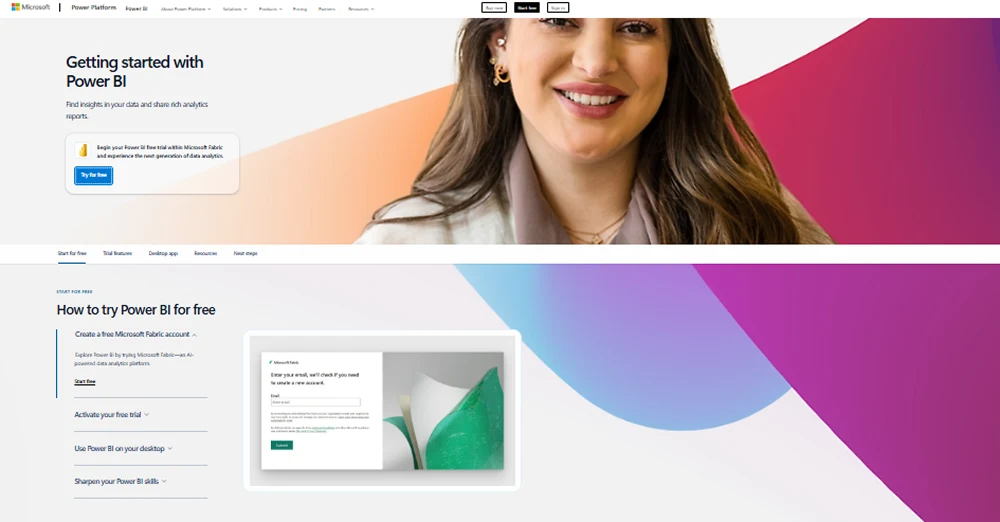Power BI(Microsoft) Overview & 2025 Industry Position
Power BI(Microsoft) is Microsoft’s powerful business intelligence suite, enabling organizations to convert vast data into actionable insights through dashboards, interactive reports, and AI-infused analytics. As of 2025, it stands among the top global analytics platforms—trusted by enterprises, SMBs, and government agencies alike. With an increasing focus on real-time collaboration, embedded AI, and seamless Microsoft ecosystem integration, Power BI(Microsoft) continues to dominate the BI sector.
From Launch to 2025: Power BI(Microsoft)’s Journey
Launched publicly in July 2015, Power BI(Microsoft) was Microsoft’s response to the rising demand for advanced, user-friendly data visualization tools. Over the years, pivotal updates included the 2017 introduction of the Power BI Embedded service, the 2020 AI-powered Q&A visual, and the shift to deep Azure integration in 2022. In 2023, Fabric was unveiled—Microsoft’s unified data platform strategy combining Power BI, Data Factory, and Synapse—positioning Power BI(Microsoft) as a central layer. By 2025, its strategic focus is delivering cloud-scale intelligence with collaborative, AI-driven decision-making hubs native to enterprise flows.

Power BI(Microsoft) Key Features
In 2025, Power BI(Microsoft) excels as a unified analytics solution offering a rich blend of traditional BI tools, AI capabilities, and collaboration-first design. Key features include:
- Fabric Integration: Unified analytics across Power BI, Azure Data Factory, and Synapse Data Science.
- AI-Powered Insights: Generative summaries, automated visuals, and Copilot-powered dataset querying.
- Real-time Dashboards: Streaming data from IoT and enterprise tools.
- Coding Flexibility: Integration with R, Python, and DAX for custom visualizations.
- Enterprise-grade Governance: Row-level security, sensitivity labels, and centralized policy management via Microsoft Purview.
Workflow & UX
Power BI(Microsoft)’s user experience stands out with its tight integration into Microsoft 365. Users can create reports in Power BI Desktop, publish to the Power BI Service, and share dashboards via Microsoft Teams or SharePoint. Copilot embeds directly in the UX allow users to describe desired analytics in natural language. Responsive dashboards adapt across devices, with mobile tuning handled via preview toggles.
Pro Tip: Use Power BI(Microsoft)’s “Smart Narrative” feature to automatically generate executive summaries with AI-driven insights and bullet-point recommendations.
Power BI(Microsoft) Pricing Analysis & Value Metrics
| Plan | Cost (Monthly/User) | Key Features |
|---|---|---|
| Free | $0 | Local report creation; no share or collaboration; publish to Desktop only. |
| Pro | $13.70 | Dashboard sharing, collaboration, Teams integration, data alerts, mobile access. |
| Premium Per User (PPU) | $27.50 | Paginated reports, AI insights, larger models (100GB), deployment pipelines. |
| Premium Capacity | Starts at $5,000 | Dedicated capacity, multi-tenant distribution, higher refresh rates. |
Value Verdict: For SMBs, the Pro and PPU plans offer a strong ROI relative to competitors, especially due to the Microsoft 365 synergy. Enterprises benefit from Premium Capacity’s scale and compliance provisions.
Competitive Landscape
| Provider | Strengths | Ideal Users |
|---|---|---|
| Power BI(Microsoft) | Microsoft 365 ecosystem, governance, embedded AI, Fabric integration | Enterprises, M365-centric teams, analysts |
| Tableau | Data exploration, interactive visuals | Creative analytics teams, designers |
| Looker (Google) | Data modeling, BigQuery synergy, modern UI | Cloud-native orgs, data engineers |
| Domo | End-to-end platform, native apps | Midmarket firms, no-code adopters |
Use Cases
Power BI(Microsoft) fits a broad range of audiences and functions:
- Retail chains analyzing regional sales by hour
- Healthcare providers tracking patient satisfaction across locations
- Manufacturers monitoring supply chain inputs via real-time dashboards
- Government agencies reporting KPIs publicly under compliance frameworks
Integrations & Ecosystem
Power BI(Microsoft) seamlessly integrates with:
- Microsoft 365 & Teams – Real-time dashboard embedding, chat-based insights
- Azure Synapse & Data Factory – Scalable warehousing and transformation
- CRMs: Salesforce, Dynamics 365
- SQL Sources: PostgreSQL, Oracle, MySQL
- ERP & Finance: SAP Hana, QuickBooks, NetSuite
Also connects to over 500 data sources via native connectors, REST APIs, and DirectQuery mode.
Pros & Cons
- Pros:
- Deep Microsoft 365 and Azure integration
- AI-assisted report writing and Copilot features
- Scalable solutions from SMBs to enterprise
- Enforced data governance and compliance support
- Cons:
- Steeper learning curve than competitors like Domo
- Premium licensing for full feature access
- Complex model management at enterprise scale
Final Thoughts
Power BI(Microsoft) remains a strong contender in 2025’s business intelligence battleground. It’s an ideal choice for organizations already within the Microsoft stack, needing scalable analytics, governance capability, and AI-driven insights. While it may not be the easiest for casual users, its value grows with scale and strategic use. Overall, a future-proof option for data-driven businesses embracing agile collaboration.
Power BI(Microsoft) Q & A
Yes, but integration features like Teams sharing and OneDrive datasets benefit most within the Microsoft ecosystem.
Absolutely. The Free and Pro tiers provide valuable tools for SMBs, with affordable upgrades as needs evolve.
PPU includes AI visuals, larger datasets, paginated reports, and advanced deployment features over Pro.
Key updates include Fabric integration, improved Copilot functionality, and tighter collaboration tools across Teams and SharePoint.
Yes. Stream analytics connectors and DirectQuery capabilities enable real-time dashboards and live alerts.